中国茶文化 - 翻译
用英文介绍中国茶文化 中国茶文化英文句子
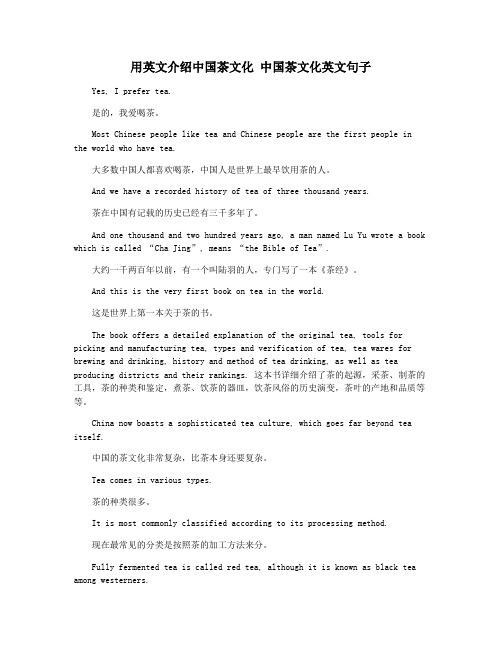
用英文介绍中国茶文化中国茶文化英文句子Yes, I prefer tea.是的,我爱喝茶。
Most Chinese people like tea and Chinese people are the first people in the world who have tea.大多数中国人都喜欢喝茶,中国人是世界上最早饮用茶的人。
And we have a recorded history of tea of three thousand years.茶在中国有记载的历史已经有三千多年了。
And one thousand and two hundred years ago, a man named Lu Yu wrote a book which is called “Cha Jing”, means “the Bible of Tea”.大约一千两百年以前,有一个叫陆羽的人,专门写了一本《茶经》。
And this is the very first book on tea in the world.这是世界上第一本关于茶的书。
The book offers a detailed explanation of the original tea, tools for picking and manufacturing tea, types and verification of tea, tea wares for brewing and drinking, history and method of tea drinking, as well as tea producing districts and their rankings. 这本书详细介绍了茶的起源,采茶、制茶的工具,茶的种类和鉴定,煮茶、饮茶的器皿,饮茶风俗的历史演变,茶叶的产地和品质等等。
China now boasts a sophisticated tea culture, which goes far beyond tea itself.中国的茶文化非常复杂,比茶本身还要复杂。
中国茶文化中英文对照翻译
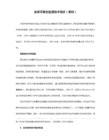
(翻译:多喝绿茶好处多多:治疗头疼、缓解抑郁、预防癌症,还能保持我们叫它“红茶”而不是“黑茶”?)
Are you ready for a science lesson - after the leaves are picked they are heat treated (殺青) to prevent oxidation. I’m sorry, I know you came here to learn English, not science, so I’ll make it easy for you – oxidation is the same process that causes metal to rust.
中国茶文化中英文对照翻译(图)
作者:佚名 稿件来源:国际在线 上传日期:2011-07-12 21:38:33
西湖龙井资讯平台7月12日讯:中国茶文化很深厚,怎么向外国人介绍呢?且看下面的双语对照翻译。
In the west there is a popular saying, “I wouldn’t give it up for all the tea in China.” For example: I love my new sports car so much, I wouldn’t give it up for all the tea in China; or, These sunglasses are soo cool, I wouldn’t trade them for all the tea in China.
(翻译:看来本人还是很喜欢绿茶的,多喝有抗癌功效哦)
There are so many varieties of green tea, though, some of the more common ones include:
中国茶文化翻译
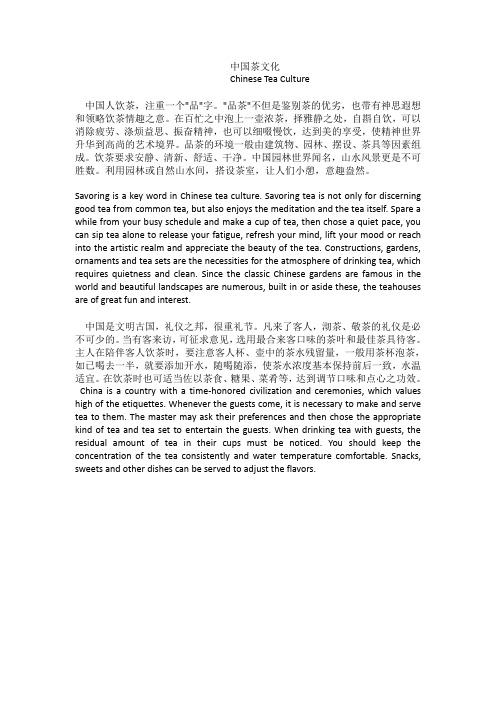
中国茶文化Chinese Tea Culture中国人饮茶,注重一个"品"字。
"品茶"不但是鉴别茶的优劣,也带有神思遐想和领略饮茶情趣之意。
在百忙之中泡上一壶浓茶,择雅静之处,自斟自饮,可以消除疲劳、涤烦益思、振奋精神,也可以细啜慢饮,达到美的享受,使精神世界升华到高尚的艺术境界。
品茶的环境一般由建筑物、园林、摆设、茶具等因素组成。
饮茶要求安静、清新、舒适、干净。
中国园林世界闻名,山水风景更是不可胜数。
利用园林或自然山水间,搭设茶室,让人们小憩,意趣盎然。
Savoring is a key word in Chinese tea culture. Savoring tea is not only for discerning good tea from common tea, but also enjoys the meditation and the tea itself. Spare a while from your busy schedule and make a cup of tea, then chose a quiet pace, you can sip tea alone to release your fatigue, refresh your mind, lift your mood or reach into the artistic realm and appreciate the beauty of the tea. Constructions, gardens, ornaments and tea sets are the necessities for the atmosphere of drinking tea, which requires quietness and clean. Since the classic Chinese gardens are famous in the world and beautiful landscapes are numerous, built in or aside these, the teahouses are of great fun and interest.中国是文明古国,礼仪之邦,很重礼节。
茶文化英语介绍
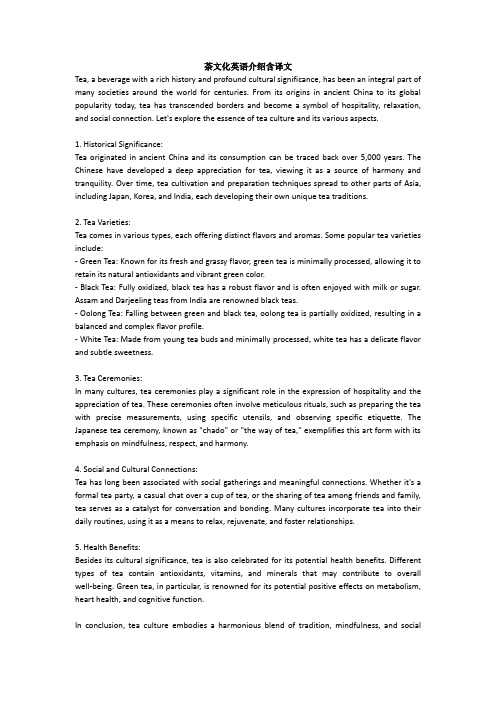
茶文化英语介绍含译文Tea, a beverage with a rich history and profound cultural significance, has been an integral part of many societies around the world for centuries. From its origins in ancient China to its global popularity today, tea has transcended borders and become a symbol of hospitality, relaxation, and social connection. Let's explore the essence of tea culture and its various aspects.1. Historical Significance:Tea originated in ancient China and its consumption can be traced back over 5,000 years. The Chinese have developed a deep appreciation for tea, viewing it as a source of harmony and tranquility. Over time, tea cultivation and preparation techniques spread to other parts of Asia, including Japan, Korea, and India, each developing their own unique tea traditions.2. Tea Varieties:Tea comes in various types, each offering distinct flavors and aromas. Some popular tea varieties include:- Green Tea: Known for its fresh and grassy flavor, green tea is minimally processed, allowing it to retain its natural antioxidants and vibrant green color.- Black Tea: Fully oxidized, black tea has a robust flavor and is often enjoyed with milk or sugar. Assam and Darjeeling teas from India are renowned black teas.- Oolong Tea: Falling between green and black tea, oolong tea is partially oxidized, resulting in a balanced and complex flavor profile.- White Tea: Made from young tea buds and minimally processed, white tea has a delicate flavor and subtle sweetness.3. Tea Ceremonies:In many cultures, tea ceremonies play a significant role in the expression of hospitality and the appreciation of tea. These ceremonies often involve meticulous rituals, such as preparing the tea with precise measurements, using specific utensils, and observing specific etiquette. The Japanese tea ceremony, known as "chado" or "the way of tea," exemplifies this art form with its emphasis on mindfulness, respect, and harmony.4. Social and Cultural Connections:Tea has long been associated with social gatherings and meaningful connections. Whether it's a formal tea party, a casual chat over a cup of tea, or the sharing of tea among friends and family, tea serves as a catalyst for conversation and bonding. Many cultures incorporate tea into their daily routines, using it as a means to relax, rejuvenate, and foster relationships.5. Health Benefits:Besides its cultural significance, tea is also celebrated for its potential health benefits. Different types of tea contain antioxidants, vitamins, and minerals that may contribute to overall well-being. Green tea, in particular, is renowned for its potential positive effects on metabolism, heart health, and cognitive function.In conclusion, tea culture embodies a harmonious blend of tradition, mindfulness, and socialconnection. With its diverse varieties, meaningful ceremonies, and health benefits, tea continues to be cherished and enjoyed by people from various cultures worldwide. Whether you're sipping a soothing cup of green tea or participating in an elaborate tea ceremony, tea invites us to appreciate the simple joys of life and embrace moments of tranquility.译文:茶是一种具有悠久历史和深厚文化意义的饮料,几个世纪以来一直是世界各地许多社会不可或缺的一部分。
英语二作文中国茶文化

英语二作文中国茶文化English: China has a rich and diverse tea culture that dates back thousands of years. Tea plays a significant role in Chinese society, not only as a popular beverage but also as a symbol of hospitality, respect, and tradition. The history of tea in China can be traced back to the Shang dynasty, and over the centuries, various tea ceremonies and rituals have developed. Chinese tea culture encompasses a wide variety of teas, including green tea, black tea, oolong tea, white tea, and pu'er tea, each with its unique flavors, aromas, and health benefits. Tea is often served during social gatherings, family reunions, and important occasions, symbolizing harmony and connection among people. The art of preparing and serving tea is highly revered in China, with elaborate tea ceremonies showcasing grace, elegance, and mindfulness. Through the simple act of sharing a cup of tea, one can experience a deep sense of tranquility, reflection, and appreciation for the present moment.中文翻译: 中国拥有着悠久丰富的茶文化,可以追溯到数千年前。
茶道英语介绍带翻译
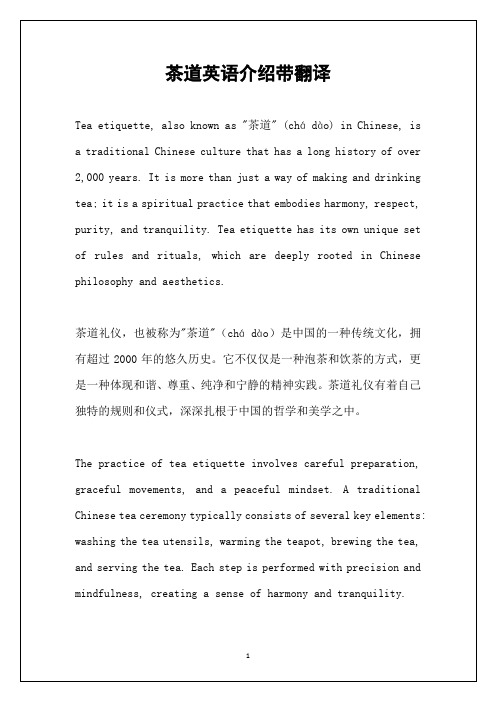
There are several key phrases and expressions in Chinese that are commonly used in the context of tea etiquette. Understanding these terms can enhance one's appreciation of Chinese tea culture and make the tea-drinking experience more enjoyable and meaningful. Here are some essential phrases related to tea etiquette, along with their English translations:
1. 茶道 (chá dào) - Tea etiquette
2. 泡茶 (pào chá) - Brewing tea
3. 茶具 (chá jù) - Tea utensils
4. 茶艺表演 (chá yì bi ǎo yǎn) - Tea art performance
5. 茶道师傅 (chá dào shī fù) - Tea master
茶道英语介绍带翻译
Tea etiquette, also known as "茶道" (chá dào) in Chinese, is a traditional Chinese culture that has a long history of over 2,000 years. It is more than just a way of making and drinking tea; it is a spiritual practice that embodies harmony, respect, purity, and tranquility. Tea etiquette has its own unique set of rules and rituals, which are deeply rooted in Chinese philosophy and aesthetics.
大学英语四级翻译练习题:茶文化.doc
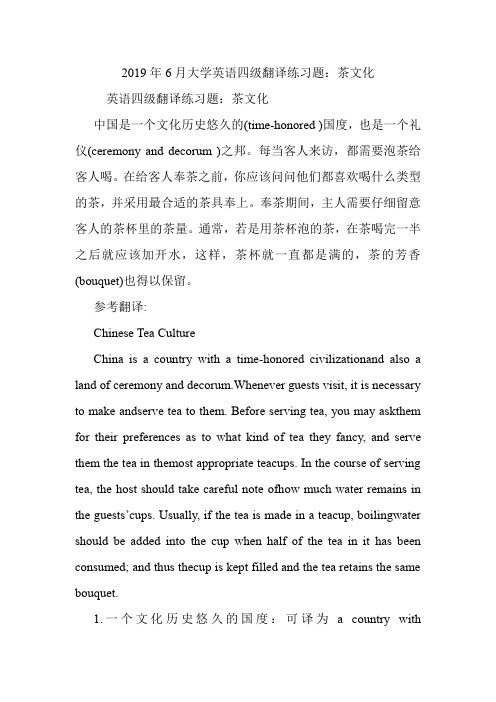
2019年6月大学英语四级翻译练习题:茶文化英语四级翻译练习题:茶文化中国是一个文化历史悠久的(time-honored )国度,也是一个礼仪(ceremony and decorum )之邦。
每当客人来访,都需要泡茶给客人喝。
在给客人奉茶之前,你应该问问他们都喜欢喝什么类型的茶,并采用最合适的茶具奉上。
奉茶期间,主人需要仔细留意客人的茶杯里的茶量。
通常,若是用茶杯泡的茶,在茶喝完一半之后就应该加开水,这样,茶杯就一直都是满的,茶的芳香(bouquet)也得以保留。
参考翻译:Chinese Tea CultureChina is a country with a time-honored civilizationand also a land of ceremony and decorum.Whenever guests visit, it is necessary to make andserve tea to them. Before serving tea, you may askthem for their preferences as to what kind of tea they fancy, and serve them the tea in themost appropriate teacups. In the course of serving tea, the host should take careful note ofhow much water remains in the guests’cups. Usually, if the tea is made in a teacup, boilingwater should be added into the cup when half of the tea in it has been consumed; and thus thecup is kept filled and the tea retains the same bouquet.1.一个文化历史悠久的国度:可译为 a country withatime-honored civilization。
中国茶道英语短语翻译大全
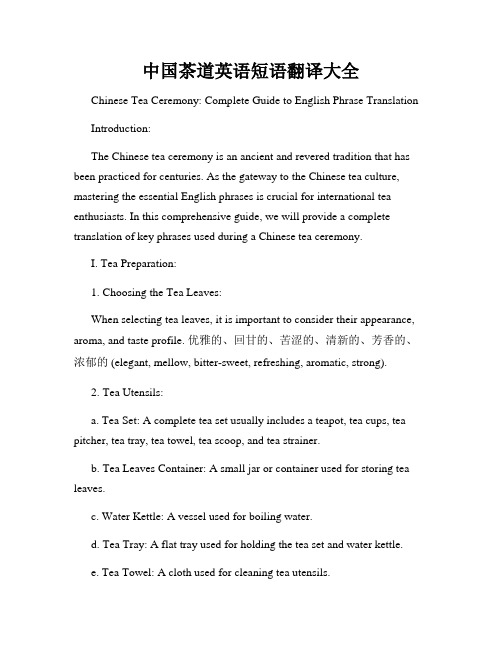
中国茶道英语短语翻译大全Chinese Tea Ceremony: Complete Guide to English Phrase TranslationIntroduction:The Chinese tea ceremony is an ancient and revered tradition that has been practiced for centuries. As the gateway to the Chinese tea culture, mastering the essential English phrases is crucial for international tea enthusiasts. In this comprehensive guide, we will provide a complete translation of key phrases used during a Chinese tea ceremony.I. Tea Preparation:1. Choosing the Tea Leaves:When selecting tea leaves, it is important to consider their appearance, aroma, and taste profile. 优雅的、回甘的、苦涩的、清新的、芳香的、浓郁的 (elegant, mellow, bitter-sweet, refreshing, aromatic, strong).2. Tea Utensils:a. Tea Set: A complete tea set usually includes a teapot, tea cups, tea pitcher, tea tray, tea towel, tea scoop, and tea strainer.b. Tea Leaves Container: A small jar or container used for storing tea leaves.c. Water Kettle: A vessel used for boiling water.d. Tea Tray: A flat tray used for holding the tea set and water kettle.e. Tea Towel: A cloth used for cleaning tea utensils.II. Tea Brewing:1. Pre-heating the Tea Utensils:Before brewing the tea, it is essential to pre-heat the tea set and cups. This helps to maintain the temperature of the brewed tea.2. Tea Brewing Steps:a. Rinse the Tea Utensils: 清洗茶具 (cleaning tea utensils).b. Add Tea Leaves: 加入适量茶叶 (add an appropriate amount of tea leaves).c. Rinse the Tea Leaves: 浸泡茶叶 (soak the tea leaves).d. Add Hot Water: 注入热水 (pour hot water).e. Steep the Tea: 泡茶 (brew tea).f. Pour the Tea: 倒茶 (pour tea).g. Serve the Tea: 服务客人 (serve guests).III. Tea Tasting:1. Appreciating the Tea:a. Tea Characteristics: 香味、滋味、色泽、汤色 (aroma, flavor, color, and infusion color).b. Tea Flavor: 醇厚、柔滑、长久回味、生津止渴 (mellow, smooth, long-lasting aftertaste, thirst-quenching).c. Tea Texture: 细腻、爽滑、口感 (delicate, refreshing, mouthfeel).d. Tea Aroma: 花香、果香、草香 (floral, fruity, grassy aroma).e. Tea Color: 金黄、琥珀、翠绿、乌黑 (golden, amber, emerald green, dark).2. Expressing Appreciation:a. Complimenting the Tea: 茶香扑鼻 (fragrant aroma), 茶味浓郁(strong flavor), 茶汤澄清 (clear infusion), 茶叶展开完整 (fully expanded tea leaves).b. Showing Gratitude: 谢谢款待 (thank you for the hospitality), 感谢品鉴 (thank you for the tea tasting).IV. Tea Etiquette:1. Guest Etiquette:a. Proper Behavior: 举止得体 (appropriate behavior), 尊重茶文化(respect for tea culture), 注重仪态 (pay attention to etiquette).b. Polite Gestures: 拱手、点头、微笑 (bow, nod, smile).c. Active Participation: 与主人互动 (interact with the host), 询问问题(ask questions), 表示兴趣 (express interest).2. Host Etiquette:a. Warm Welcome: 热情接待 (warm reception), 热情招待客人(warmly entertain guests).b. Guiding the Ceremony: 主持茶道仪式 (host the tea ceremony), 细致讲解 (detailed explanation), 示范冲泡 (demonstrate brewing).c. Attentiveness: 注意客人需求 (attend to guest's needs), 提供优质服务(provide excellent service).Conclusion:Mastering the English phrases used in a Chinese tea ceremony is essential for tea enthusiasts seeking to fully appreciate and understand this ancient art form. By understanding the translation of key phrases related to tea preparation, brewing, tasting, and etiquette, individuals can actively participate and engage in this traditional ceremony. So, grab your tea set and start practicing these phrases to elevate your tea-drinking experience. Cheers!。
中国茶文化英文介绍(1)
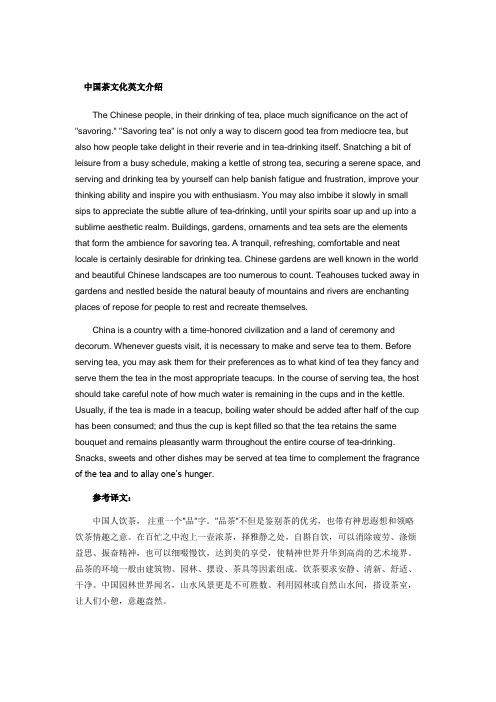
中国茶文化英文介绍The Chinese people, in their drinking of tea, place much significance on the act of "savoring." "Savoring tea" is not only a way to discern good tea from mediocre tea, but also how people take delight in their reverie and in tea-drinking itself. Snatching a bit of leisure from a busy schedule, making a kettle of strong tea, securing a serene space, and serving and drinking tea by yourself can help banish fatigue and frustration, improve your thinking ability and inspire you with enthusiasm. You may also imbibe it slowly in small sips to appreciate the subtle allure of tea-drinking, until your spirits soar up and up into a sublime aesthetic realm. Buildings, gardens, ornaments and tea sets are the elements that form the ambience for savoring tea. A tranquil, refreshing, comfortable and neat locale is certainly desirable for drinking tea. Chinese gardens are well known in the world and beautiful Chinese landscapes are too numerous to count. Teahouses tucked away in gardens and nestled beside the natural beauty of mountains and rivers are enchanting places of repose for people to rest and recreate themselves.China is a country with a time-honored civilization and a land of ceremony and decorum. Whenever guests visit, it is necessary to make and serve tea to them. Before serving tea, you may ask them for their preferences as to what kind of tea they fancy and serve them the tea in the most appropriate teacups. In the course of serving tea, the host should take careful note of how much water is remaining in the cups and in the kettle. Usually, if the tea is made in a teacup, boiling water should be added after half of the cup has been consumed; and thus the cup is kept filled so that the tea retains the same bouquet and remains pleasantly warm throughout the entire course of tea-drinking. Snacks, sweets and other dishes may be served at tea time to complement the fragrance of the tea and to allay one’s hunger.参考译文:中国人饮茶,注重一个"品"字。
英文作文茶文化附中文翻译
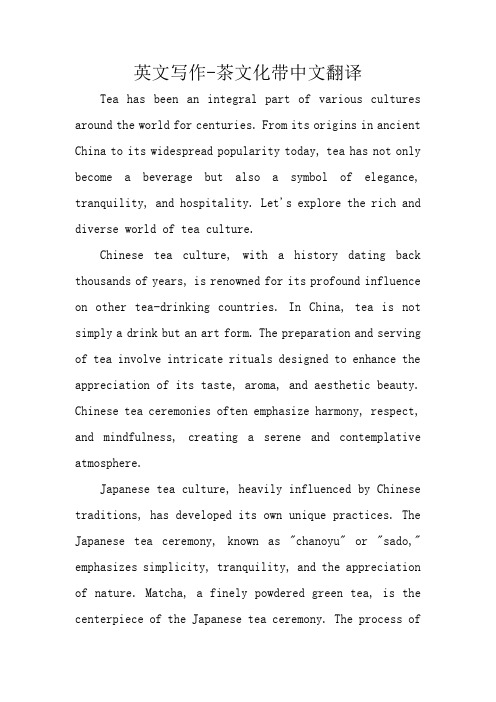
英文写作-茶文化带中文翻译Tea has been an integral part of various cultures around the world for centuries. From its origins in ancient China to its widespread popularity today, tea has not only become a beverage but also a symbol of elegance, tranquility, and hospitality. Let's explore the rich and diverse world of tea culture.Chinese tea culture, with a history dating back thousands of years, is renowned for its profound influence on other tea-drinking countries. In China, tea is not simply a drink but an art form. The preparation and serving of tea involve intricate rituals designed to enhance the appreciation of its taste, aroma, and aesthetic beauty. Chinese tea ceremonies often emphasize harmony, respect, and mindfulness, creating a serene and contemplative atmosphere.Japanese tea culture, heavily influenced by Chinese traditions, has developed its own unique practices. The Japanese tea ceremony, known as "chanoyu" or "sado," emphasizes simplicity, tranquility, and the appreciation of nature. Matcha, a finely powdered green tea, is the centerpiece of the Japanese tea ceremony. The process ofpreparing and serving matcha involves precise movements and gestures, showcasing the beauty of minimalism and attention to detail.In India, tea holds a significant cultural and social importance. Masala chai, a spiced tea blend, is a popular choice in Indian households. Tea is not only enjoyed as a refreshing beverage but also serves as a catalyst for social gatherings and discussions. The concept of "chai pe charcha," meaning "tea and conversation," reflects the role of tea as a facilitator of connections and conversations among people.Tea culture is not limited to East Asia and India. In the United Kingdom, the tradition of afternoon tea holds a special place. It is a cherished ritual that typically involves tea served with scones, finger sandwiches, and pastries. The British take pride in their tea etiquette, with proper teapot pouring techniques and the use of fine china.No matter where tea culture is embraced, it promotes a sense of relaxation, mindfulness, and social interaction. Whether it is a formal ceremony or a casual gathering with friends, tea offers a moment of pause in our busy lives,allowing us to appreciate the simple pleasures and connect with others.中文翻译为:茶在世界各地的文化中已经有数百年的历史,它不仅成为一种饮料,更是优雅、宁静和热情待客的象征。
茶文化英语作文带翻译3篇

茶文化英语作文带翻译茶文化英语作文带翻译3篇在生活、工作和学习中,大家都有写作文的经历,对作文很是熟悉吧,借助作文人们可以反映客观事物、表达思想感情、传递知识信息。
一篇什么样的作文才能称之为优秀作文呢?下面是小编为大家收集的茶文化英语作文带翻译,希望能够帮助到大家。
茶文化英语作文带翻译篇1Since I started my major in the tea culture of ChinaI have been deeply impressed by its sophistication and beauty.I would like to share some fascinating aspects of the tea culture of China.In a country with the history of five thousand yearsthe Chinese tea drinking habit dated back to the Tang Dynasty (618-907AD).It became a national tradition and led to development of a delicate tea drinking ritual.Over the centuriespoets and artists in China wrote many marvelous masterpiecesin appreciation of tea and Chinese people’s constant love of tea drinking .One of the best-known writers is Lu Yuwho was regarded as the “Tea Sage ” for he composed the first book on tea.In his classic bookhe detailed his studies of teasuch as the origin of teatea toolstea pickingtea cookingtea ceremony and well-known areas where tea was grown.And the valuable knowledge he recorded has laid foundation for modern tea culture development.based on ways in which tea leaves are processedthere are five distinct types of tea.They are as follow:the green teathe black teathe Wulong teathe compressed tea and the scented tea.Among themmay foreigners are familiar with the green tea.The Longjing teaof the green typehas a reputation.自从我开始在中国的茶文化专业,我已深深感受到它的精致和美丽。
中国茶文化常识英语作文

英文作文:The Essentials of Chinese Tea CultureChinese tea culture is an integral part of the country's rich heritage, deeply ingrained in its history and traditions. It is not just a beverage but a way of life, reflecting the harmonious blend of nature, art, and philosophy.The history of tea in China dates back thousands of years, with various legends and stories surrounding its discovery. Over time, tea has evolved into various categories, including green tea, black tea, oolong tea, and white tea, each with its unique aroma, taste, and brewing methods.The preparation of tea is an art in itself. It involves meticulous steps like selecting the right type of tea, heating the water to the perfect temperature, and pouring it over the leaves. The process requires patience and attention to detail, ensuring that the tea retains its natural flavors and aroma.Moreover, tea drinking in China is often accompanied by rituals and ceremonies. These not only enhance the overall experience but also promote social interaction and cultural exchange. For instance, the "gongfu cha" ceremony, which originates from Fujian province, is a highly sophisticated way of preparing and enjoying tea. The benefits of tea are numerous. It is known to aid digestion, boost metabolism, and have relaxing effects. In traditional Chinese medicine, tea is also believed to have medicinal properties that can help with various health conditions.In conclusion, Chinese tea culture is a profound and multifaceted aspect of the country's cultural identity. It embodies the harmonious coexistence of nature and humanity, and its practice contributes significantly to personal well-being and societal cohesion.中文翻译:中国茶文化的常识中国茶文化是中国丰富遗产中不可或缺的一部分,深深植根于历史与传统之中。
【关于茶文化的英文作文】茶文化英文

【关于茶文化的英文作文】茶文化英文【关于茶文化的英文作文】茶文化英文茶文化的发展回事我们的使命,所以出现了很多的关于茶文化的英文作文和论文。
下面是小编精心为你整理的关于茶文化的英文作文,一起来看看。
关于茶文化的英文作文1 茶文化Chinese tea Chinese tea culture, tea culture. As open seven things , one of tea in ancient China is very common. Chinese tea culture and tea culture in Europe and America or Japan, a great difference. Chinese tea culture has a long history, profound, not only contains the material and cultural level, also contains a deep spiritual level.Tea by Lu Yu of the Tang Dynasty in the history of Chinese tea culture and sounded the horn. Since then, the spirit of tea permeates the court and society, into the Chinese poetry, painting, calligraphy, religion, medicine. For thousands of years China has not only accumulated a great deal about tea cultivation, production of material culture, but also accumulated rich spirit of the tea culture, which is unique to China’s tea culture, a cultural study areas.中国茶,茶文化,茶文化。
茶文化英语句子与翻译
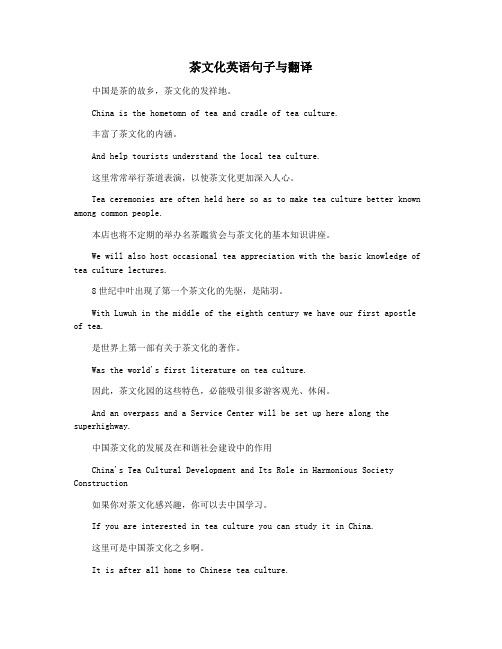
茶文化英语句子与翻译中国是茶的故乡,茶文化的发祥地。
China is the hometomn of tea and cradle of tea culture.丰富了茶文化的内涵。
And help tourists understand the local tea culture.这里常常举行茶道表演,以使茶文化更加深入人心。
Tea ceremonies are often held here so as to make tea culture better known among common people.本店也将不定期的举办名茶鑑赏会与茶文化的基本知识讲座。
We will also host occasional tea appreciation with the basic knowledge of tea culture lectures.8世纪中叶出现了第一个茶文化的先驱,是陆羽。
With Luwuh in the middle of the eighth century we have our first apostle of tea.是世界上第一部有关于茶文化的著作。
Was the world's first literature on tea culture.因此,茶文化园的这些特色,必能吸引很多游客观光、休闲。
And an overpass and a Service Center will be set up here along the superhighway.中国茶文化的发展及在和谐社会建设中的作用China's Tea Cultural Development and Its Role in Harmonious Society Construction如果你对茶文化感兴趣,你可以去中国学习。
If you are interested in tea culture you can study it in China.这里可是中国茶文化之乡啊。
介绍中国茶文化已经一种茶英语作文
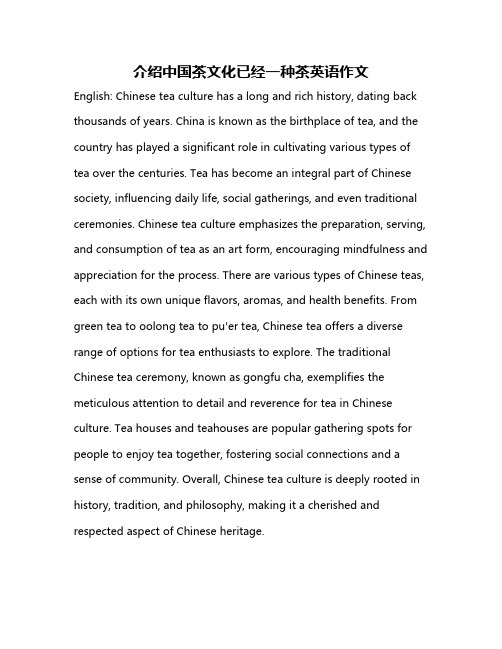
介绍中国茶文化已经一种茶英语作文English: Chinese tea culture has a long and rich history, dating back thousands of years. China is known as the birthplace of tea, and the country has played a significant role in cultivating various types of tea over the centuries. Tea has become an integral part of Chinese society, influencing daily life, social gatherings, and even traditional ceremonies. Chinese tea culture emphasizes the preparation, serving, and consumption of tea as an art form, encouraging mindfulness and appreciation for the process. There are various types of Chinese teas, each with its own unique flavors, aromas, and health benefits. From green tea to oolong tea to pu'er tea, Chinese tea offers a diverse range of options for tea enthusiasts to explore. The traditional Chinese tea ceremony, known as gongfu cha, exemplifies the meticulous attention to detail and reverence for tea in Chinese culture. Tea houses and teahouses are popular gathering spots for people to enjoy tea together, fostering social connections and a sense of community. Overall, Chinese tea culture is deeply rooted in history, tradition, and philosophy, making it a cherished and respected aspect of Chinese heritage.中文翻译: 中国茶文化拥有悠久而丰富的历史,可以追溯到数千年前。
- 关于中国茶文化的英语作文带翻译

关于中国茶文化的英语作文带翻译关于中国茶文化的英语作文带翻译篇一:中国茶文化In China, tea has a very long history, and has formed a Chinese tea culture. At the same time, tea is good for our health and is loved by many people. Chinese tea culture is broad and profound. It includes not only material culture, but also profound spiritual civilization. Talking about Chinese tea. Can be traced back to ancient times, it is from the Tang Dynasty and Song Dynasty flourished.From then on, the spirit of tea permeated the court and society, and went deep into Chinese poetry, painting, calligraphy, religion and medicine. For thousands of years, China has accumulated a large number of tea cultivation and production of material culture, but also enriched the spiritual culture of tea.【参考译文】在中国,茶具有非常悠久的历史,并且已经形成了中国茶文化。
与此同时,茶有益于我们的健康,因此受到许多人的喜爱。
中国茶文化博大精深,不但包含物质文化层面,还包含深厚的精神文明层面。
茶文化
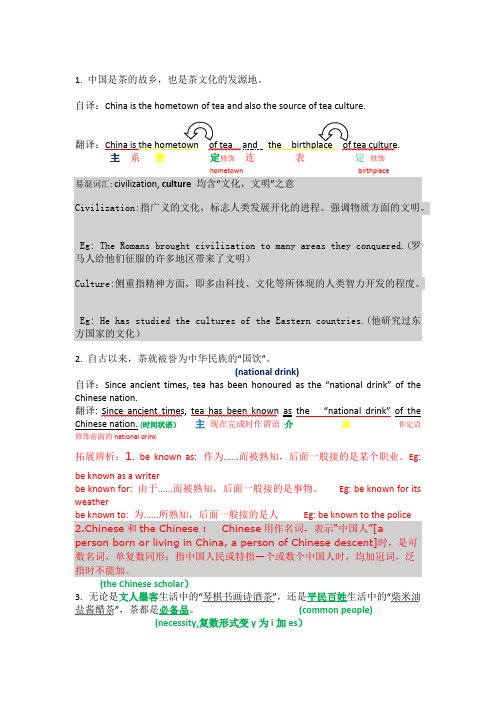
1. 中国是茶的故乡,也是茶文化的发源地。
自译:China is the hometown of tea and also the source of tea culture.翻译:China is the hometown of tea and the birthplace of tea culture.主系表定修饰连表定修饰hometown birthplace易混词汇: civilization, culture均含“文化,文明”之意Civilization:指广义的文化,标志人类发展开化的进程。
强调物质方面的文明。
Eg: The Romans brought civilization to many areas they conquered.(罗马人给他们征服的许多地区带来了文明)Culture:侧重指精神方面,即多由科技、文化等所体现的人类智力开发的程度。
Eg: He has studied the cultures of the Eastern countries.(他研究过东方国家的文化)2. 自古以来,茶就被誉为中华民族的“国饮”。
(national drink)自译:Since ancient times, tea has been honoured as the “national drink” of the Chinese nation.翻译: Since ancient times, tea has been known as the “national drink” of the Chinese nation. (时间状语)主现在完成时作谓语介宾作定语修饰前面的national drink拓展辨析:1. be known as: 作为......而被熟知,后面一般接的是某个职业。
Eg: be known as a writerbe known for: 由于......而被熟知,后面一般接的是事物。
- 1、下载文档前请自行甄别文档内容的完整性,平台不提供额外的编辑、内容补充、找答案等附加服务。
- 2、"仅部分预览"的文档,不可在线预览部分如存在完整性等问题,可反馈申请退款(可完整预览的文档不适用该条件!)。
- 3、如文档侵犯您的权益,请联系客服反馈,我们会尽快为您处理(人工客服工作时间:9:00-18:30)。
Translate the following paragraph into English.
中国素有“茶的故乡”之称,是世界上最早种植茶、制作茶、饮用茶的国家。
茶是世界三大饮料之一,茶的发现和利用是中国人对人类文化史的一大贡献。
中国历史悠久的饮茶历史,形成了颇有特色的中华茶文化。
茶成为人们生活中不可缺少的一部分,它不仅是一种饮品,而且是文化的传播者,代表了中国人独特的哲学思想、美学观点和生活方式,它能体现中国人的精神世界。
中国茶文化不仅指泡茶的方法、茶具和饮茶的场合,还包括茶诗、茶画及茶俗。
China, the homeland of tea, is the first country to grow, produce and drink tea. The discovery of tea, one of the three beverages of the world, is a great contribution to the history of human culture. China has a long history of tea drinking history, has formed a distinctive Chinese tea culture.Tea become an indispensable part of people's life, it is not only a drink, and it's culture, representing the Chinese unique philosophy, aesthetic views and way of life, it can reflect the spirit of Chinese people in the world.Chinese tea culture is not only refers to the method of make tea, tea sets and tea drinking occasions, also includes tea, tea and tea poetry.。
